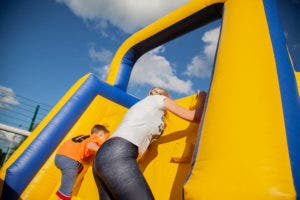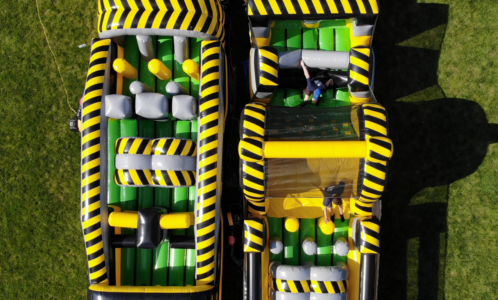Obstacle Course Ideas Don’t Always Come Naturally
At first glance, designing an obstacle course seems like it would be a fun, relatively easy project. It’s usually not until you really start putting your pen to paper that you realize you have no idea how to make an obstacle course hit all of the marks it rightly should hit.
A great obstacle course needs to challenge a participant physically and mentally. It should include tests of strength, stamina, agility, gross motor skills (walking, running, jumping, crawling, etc.), and cognitive skills like hand-eye coordination, logic, reasoning, etc. And you need to try and deliver as much of that as possible within the financial and spacial budgets available to you.
You need to design it in such a way that people can actually complete it, too. That’s a whole other challenge to consider. Oh, and you need to be able to actually set up an obstacle course as well, which is sometimes easier said than done. Figuring out how to make an obstacle course only really matters if you're able to complete the "making" part, you know?
Researching how to build an obstacle course will inevitably lead you to suggestions for trying commercial inflatables, particularly commercial grade inflatable obstacle courses. And that’s something we here at Tent and Table know quite a bit about; we make inflatable obstacle courses, after all. So let’s get to designing the perfect inflatable obstacle course for your needs, shall we?
Know Your Needs
 Before we start browsing commercial inflatables and daydreaming about how one person or another might complete an obstacle, we first need to know who this obstacle course is actually for. That’s going to play a huge role in determining what equipment we should use and how that equipment should be arranged.
Before we start browsing commercial inflatables and daydreaming about how one person or another might complete an obstacle, we first need to know who this obstacle course is actually for. That’s going to play a huge role in determining what equipment we should use and how that equipment should be arranged.
Kids love obstacle courses as much as adults do, but obstacle courses for kids will be significantly different from those designed for adults. Adults are obviously larger; they can’t fit in the same spaces as a child, and will move faster or slower through certain obstacles.
Now that we know who is using it, we need to know what we’re using it for. An inflatable obstacle course can be used at a wide assortment of events. From fun gatherings like birthday parties or festivals to more purpose-driven events like fundraisers or team building exercises, commercial inflatable obstacle courses are great additions to any party or event you’re organizing.
The difficulty level of your obstacle course should be scaled appropriately to suit that event, as well as to the general participants who will be using it. So try to keep all of that in mind as you progress forward. You obviously don’t want to incorporate the same sort of challenges you’d find in a Tough Mudder, Rugged Maniac, or Spartan Race into an obstacle course for children at a birthday party. Figuring out how to make an obstacle course targeted to your key demographic is easier once you've really identified who that demographic really is.
How to Make an Obstacle Course Safe
Nothing sours a good time faster than an injury. And if your obstacle course is too dangerous, most people aren’t going to be interested in giving it a go. Knowing how to make an obstacle course safe is just as important as knowing how to make an obstacle course fun or challenging.
Thankfully, most commercial inflatables are inherently safe to begin with. By simply observing all of the safety rules of each of the inflatables you’re using, you’re instantly adhering to good safety standards. Just be sure to incorporate good safety practices between your various obstacles and other elements, too.
Use ropes, pool noodles, or other visual markers on the ground to define a clear path for your participants from one obstacle to the next. And if there are large gaps between commercial inflatables, you may want to consider using tarps on the ground to prevent your course from turning into a mud run. You don’t want to spend the rest of your life cleaning bounce houses and inflatable slides, right? And what’s worse, all of that mud and grime can make your inflatables unstable and unsafe.
Be sure to have a first aid kit available. Inflatables by their very nature tend to minimize bumps and scrapes, but they’re still possible. And pulled muscles can happen anywhere; it’s always a good idea to keep an ice pack, some bandages, and some pain relievers on hand, just in case.
Did you know most of the commercial inflatables we sell here at Tent and Table can be connected together directly? Lacing them is pretty simple, as one of our staff shows in the video below. Lacing commercial inflatables together minimizes space between obstacles and reduces the risk of injury from mounting and dismounting commercial inflatables repeatedly in a sequence.
Choosing Major Components: Your Big Commercial Inflatables
One of the coolest elements of inflatable obstacle courses is how incredibly modular they are. A single unit by itself makes for a fun inflatable game. Many units even feature side-by-side inflatable obstacle course races. But as we mentioned earlier, you can connect a few units together to make a whole backyard obstacle course, all with minimal effort.
[product ids="2293,3565,3580,3589"]
Most of the inflatable obstacle courses for sale on our website are designed for modular compatibility with other units. That means you can mix and match various commercial inflatables and put together whatever combination of challenges you’d like. Some units are solely designed to bridge one unit to another, like U-turn inflatable obstacle courses designed to turn participants around and into a new lineup of inflatable games.
You could also come up with clever ways of blending in the use of inflatable bounce houses, inflatable water slides, zorb balls (with or without zorb ball tracks), and more. And when your competitors need to take a break from physical exertion, you could put in a small play area where they need to complete an air frame game or an inflatable ultralite game before advancing onto the next stage.
[product ids="2431,2490,5091,5681"]
Commercial inflatables can be used to make an outdoor or indoor obstacle course, depending on the locations available to you. And they can be loaded up with bonus kids activities or adult ones to spice up the fun. This is where you really get to let your creativity fly!
How to Make an Obstacle Course Even More Fun
You don’t necessarily need to attach your commercial inflatables together in a sequence. As we mentioned earlier, you may want to leave some space between your larger units. But what are your participants doing between those two larger obstacles? Does the fun need to stop while they travel, or can you keep the obstacle course going between those main events?
You could fill the gap between primary obstacles with smaller, simpler, secondary ones. We mentioned some of these earlier; race in a zorb ball from one obstacle to the next, over land or a pool of water, or play an air frame game.
There are other secondary challenges you could utilize, too. A tire obstacle course, or running through cones, or crossing over a balance beam with gym mats below it are all great options for secondary courses that fill in those aforementioned gaps between main attractions.
[product ids="3467,4064,4332,3551"]
Does your event have any other goals in mind, beyond fun? These secondary courses are great places to put in calls to action for fundraising efforts or establish additional team building exercises. With functional bonus space, it's easy to come up with great ideas for hitting those goals of yours.
How to Make an Obstacle Course Great Experiences
Strip away all of the buzzwords and seemingly unnecessary marketing language, and an obstacle course ends up having little to do with the fun you can have or the challenges you can endure. Those are all great in the moment, but it’s what you take home from your obstacle course experience that matters most.
The primary objective of your event isn’t to create an awesome obstacle course. It’s to create memories. It doesn’t matter what your short-term goals are, even. You could’ve come here hoping to find out how to build an obstacle course in your backyard, or how to build a military style obstacle course, or how to build an obstacle course for adults and children to share. But it’s those memories your participants leave with that really matter, above all else.
Knowing how to make an obstacle course begins and ends with appreciating how to make an event memorable. And it’s this immeasurable, unquantifiable metric that really matters the most. So at the end of the day, don’t worry too much about making it challenging or unbeatable. Focus that energy instead of making your inflatable obstacle course fun, safe, and memorable. The challenging stuff? That will mostly come naturally through the process of forming not an obstacle course, but a great memory.



